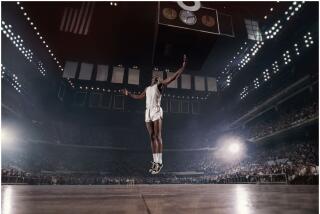A Look at 3-D, From Its 19-Century Roots
- Share via
SAN DIEGO — As a leading advocate of 3-D technology, Ray Zone spends much of his time breaking down stereotypes, the image of people with cardboard glasses watching blurry movies about mutant lizards.
“Professionally and artistically, I’m working to demonstrate that 3-D is not just a gimmick or a fad, but a form of visual communication for two eyes,” said Zone, who will lecture at the Reuben H. Fleet Space Theater and Science Center at 7:30 p.m. Wednesday. The Fleet Theater is spotlighting 3-D, reviving the popular film “We Are Born of Stars” and a detailed exhibit, “3-D: A Look in Depth” in the Science Center. Zone’s free lecture is titled “The Deep Image: 3-D in Art and Science,” and it will include a stereo slide tracing the history of 3-D back to its roots in the 19th Century.
“Few people realize the majority of photos Matthew Brady shot were in 3-D,” Zone said, referring to the Civil War photographer. “Portraits he did of Lincoln were in 3-D.”
Zone has spent the past 10 years of his life trying to persuade people of the wealth of applications for 3-D, with or without glasses, and ranging from point-of-purchase displays to TV shows.
“Part of the visual bias of our culture is an increasing thirst for images that are more resolute, more reality, more drama,” Zone said.
Zone and his company, the 3-D Zone, work on 3-D slide shows, videos, yearbooks and just about anything else he can think of that would benefit from a more detailed image. He specializes in converting “flat” images to 3-D.
Besides business applications, primarily in advertising--presenting customers with a much more interesting and arresting image--Zone believes 3-D will become part of home life. Television shows will be in 3-D, as well as art and literature.
“The next step is to refine the quality of the image so it has more impact,” Zone said.
He has been a fan of the medium since he was a child in the ‘50s, when three-dimensional movies were the rage.
“They changed my life. I went to as many 3-D films as I could.”
His first professional introduction to the medium was helping to write a comic book, “Battle of the 3-D World.” That helped him land a job working on comic books, which introduced him to the many applications of 3-D.
His company works on a variety of 3-D products, from murals to underwear. He also works as a consultant, advising companies and individuals how they can use 3-D to expand their horizons.
Basically, Zone said, there are two forms of 3-D images: those that don’t require glasses, such as holograms, and the more conventional images that require glasses to view clearly.
“For me, the glasses are pure 3-D in the most interactive sense,” Zone said. “Glasses, in a way, are part of the romance of 3-D. They’re a window to another reality.”
Of course, the glasses also represent the negative side of 3-D, the lasting image that 3-D is only used for bad movies. More than anything, Zone wants to break people’s prejudices about 3-D. It comes in and out of popularity; Zone wants to make it part of everyday life.
“There is a cyclical character to 3-D,” he said. “The cycle that it returns every 30 years has been broken.”
Zone’s lecture will cover the history of 3-D in movies and comics, as well as the more advanced scientific applications in geology, astronomy, X-rays, microscopy and space exploration.
Reservations for the lecture are not required, but seating is limited.
More to Read
The biggest entertainment stories
Get our big stories about Hollywood, film, television, music, arts, culture and more right in your inbox as soon as they publish.
You may occasionally receive promotional content from the Los Angeles Times.










